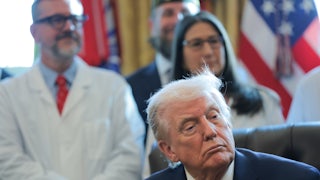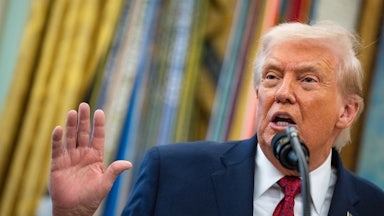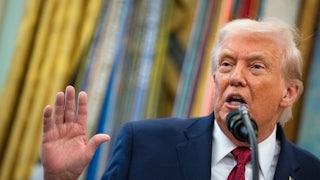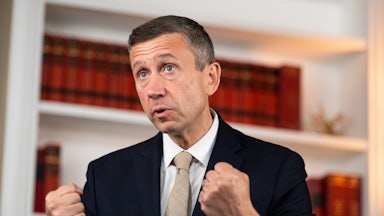“This is America’s border czar, and she’s failed us,” says the narrator in Donald Trump’s first attack ad against Kamala Harris, which features footage of the vice president dancing followed by a series of statistics describing chaos at the southern border, including “over 10 million illegal border crossings” and “250,000 Americans dead from fentanyl.”
From the moment Harris became the presumptive Democratic nominee for president, Republicans have attacked her record on immigration, which clearly they perceive as her greatest weakness. Trump and his campaign surrogates have dubbed her “Biden’s failed border czar,” including at the one and only debate.
Harris, too, seems to perceive immigration as a vulnerability in her campaign. Thus far, her only rebuttal to the Republicans’ attacks has been to tout her support of the bipartisan border security bill and to criticize Trump for ordering his supporters in Congress to walk away from that legislation. She has been relatively silent on exactly what her immigration role has been in the Biden administration—not to mention what her current immigration positions are as a candidate for president.
The truth is that Harris never was Biden’s border czar. Early in his presidency, Biden put Harris in charge of a program that would tackle the root causes of migration from the Northern Triangle countries of El Salvador, Honduras, and Guatemala, where many of the migrants to the U.S. come from. In effect, the idea was to cut off migration at its source with a robust economic development plan. The program appears to be working. The number of migrants crossing the southern border has dropped precipitously in recent months, with Harris’s efforts in Central America playing a contributing role. And yet, she does nothing to tout her success.
Rather than shrink from her immigration record as a political liability, Harris should lean into it on the campaign trail as a political asset. She can start this Friday when, for the first time since becoming the nominee, she visits the southern border. Harris can help the nation see that the kind of economic development she fostered in Central America can cut pressure on our border and serve as a critical complement to traditional “at the border” security.
Since the spring of 2021, when Biden first put Harris in charge of the Root Causes Strategy, the vice president has led the effort to secure commitments from international corporations to invest more than $5.2 billion in the Northern Triangle. As 77 percent of migrants from the region are driven out by lack of economic opportunity, the idea is that if you can incentivize regional governments to create conditions on the ground to attract investment, and then boost and stabilize the economy, many of those migrants will opt to stay home. Thus far, more than $1.1 billion of the money raised by Harris has been deployed, resulting in more than 90,000 new jobs, workforce training for 388,000 people, 3.5 million individuals obtaining bank accounts or access to credit, and digital access for 4.5 million people, according to the Partnership for Central America.
Jonathan Fantini-Porter is the executive director of Partnership for Central America, the nongovernmental organization that was set up to coordinate and manage Harris’s Call to Action in the Northern Triangle. A member of the Biden-Harris Transition Team, Fantini-Porter told me that Harris was involved in building the Central America plan from the start with business and civil society leaders.
“One of the tasks that we were given by the vice president was, let’s figure out what the right model is here that the experts in this field have identified as the path to a solution. She launched the Central America plan with us sitting around a table on May 24, 2021, and has since then led the effort to drive this forward.”
The data for the Northern Triangle paints an intriguing picture. According to a Congressional Research Service report, U.S. Border Patrol encounters at the southern border with Guatemalan, Honduran, and Salvadoran nationals spiked dramatically between 2017 and 2019, before the Covid-19 pandemic. During that same period, when the Trump administration was prioritizing an enforcement approach to immigration, World Bank data shows a decrease in foreign direct investment, or FDI, in the region. Since 2021, those trend lines have reversed, with Border Patrol encounters with Guatemalan, Honduran, and Salvadoran nationals falling as more FDI flows into the Northern Triangle.
“Something is occurring in this region that is causing people to not want to leave as much as they previously were,” said Fantini-Porter. “We would argue that one factor is that you’re seeing economic activity occur.”
To be sure, there are other factors suppressing migration from the Northern Triangle, such as the deterrent effects of Biden’s executive order partially banning asylum claims, the Mexican government’s crackdown on migrants traveling through its territory, and a perilously hot summer making the journey even more arduous. Others point to the Bukele effect in El Salvador, where a draconian approach to law enforcement has resulted in a dramatic reduction in the murder rate there. In any event, it would be folly not to consider the impact of economic development in the region by the Partnership for Central America.
Beyond crediting Harris for setting the vision for the Root Causes Strategy, which is the first time the federal government has used a public-private partnership model to tackle U.S. immigration challenges, Fantini-Porter says that the vice president has been intimately involved in moving the Central America program forward. He cites the example of Yazaki, a global auto parts manufacturer based in Japan. Fantini-Porter says Harris personally invited Itaru Motobayashi, the executive vice president of Yazaki North America, to the Summit of the Americas in 2022, held in Los Angeles, to pitch him on investing in Central America “as a path to secure their supply chain,” he recalled. In a follow-up meeting with Harris, Motobayashi committed to investing $30 million in a new wire harness manufacturing facility in the western highlands of Guatemala, which opened in 2023 and resulted in more than 7,000 jobs in a region known for a high rate of exit migration.
“And importantly, that factory also contributes to an integrated supply chain between the United States and Central America,” said Fantini-Porter. “Those car harness parts go into cars that are then manufactured and sold in the United States. You end up having this integrated supply chain benefit that helps not only reduce migration but also create jobs in the United States and supports the geopolitical conditions that are so important right now to the Americas in terms of challenging Chinese incursion in this region.”
So why isn’t Harris touting her success in addressing the root causes of migration? No doubt she believes—or her advisers believe—that the less she talks about immigration, the better. But trumpeting her accomplishments in Central America, as well as her support for the bipartisan reform bill that Trump ordered Republicans to block, will show voters that she pursues real solutions—rather than using immigration as a political cudgel like her opponent does—and it will help voters understand that the border crisis requires a two-pronged approach of enforcement and economic development.
“When people talk about the humanitarian crisis at the border, clearly it’s a symptom of a more deep, entangled set of conditions in the region where people are coming from,” Ariel Ruiz Soto, a policy analyst at the Migration Policy Institute, told my colleague at Ideaspace last year for a deeply reported article about the Root Causes Strategy. “There’s a regional crisis and the border is one of the consequences of that regional crisis. Trying to solve or address irregular migration at the U.S.-Mexico border is already too late. What we need to do is better manage how migration happens.”
Harris has shown real vision and leadership in addressing how that migration happens. She expertly wielded her soft power in bringing together business and civil society leaders and personally recruiting global corporations to open up shop in the Northern Triangle, giving would-be migrants a reason to stay home. The irony of the “Biden’s failed border czar” attack is that she has been precisely the opposite of a failure.






